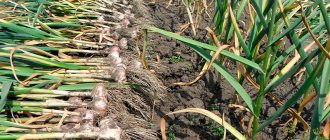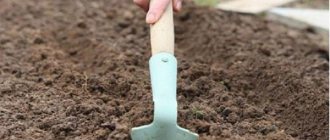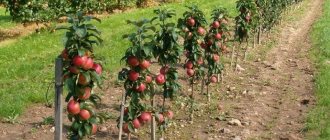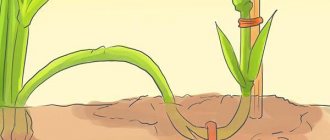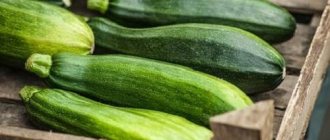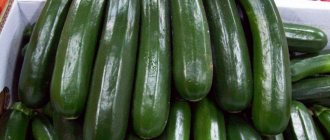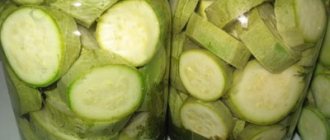Short description
Zucchini is an annual crop from the pumpkin family. Originally, like their ancestors, these vegetables were known as creeping bush plants. Nowadays, growing bush varieties is more practiced.
Bush. It has five-pointed leaves placed on elongated petioles. A fairly abundant herbaceous mass can protect the root from premature drying.
Leaves. They leave the impression of a creative masterpiece. Many bush varieties have whitish patterns on the green background of the leaves.
Flowers. Different-sex bells densely inhabit the bush and are characterized by their yellow color.
Root. Spreading system of surface type. Adventitious shoots are located on the sides of the lateral roots.
What is important to know when planting zucchini
The area where zucchini will grow must be accessible to sunlight and protected from drafts.
Light soils are better suited. Therefore, humus, straw and crushed green manure are first added to it. Also, depending on the composition of the soil, ash and mineral fertilizers are added to it.
The next point is to find out what to plant zucchini after. Sometimes gardeners cannot understand the reason for a bad harvest. It would seem that the place is suitable, and the soil is fertile, but the return is unimportant. It turns out that the culture that had previously grown in the garden played a role.
Some people already know the concept of crop rotation. It is increasingly affecting the field of gardening.
What is crop rotation
Crop rotation is the alternation of planting crops in the same area. This method is scientifically proven; in particular, it is used on a large scale in the fields. Some gardening enthusiasts could observe in practice how crop rotation has a positive effect on the harvest.
The method in question does not occur chaotically. Each plant has its own predecessors. To decide which crops you can plant zucchini after, you should be guided by a number of factors:
- Plants have an individual need to consume chemical elements from the soil. Each successive cultivation of a crop changes its composition.
- The natural structure of the soil layer is of great importance for plants. Also, the level of digging may be different. Sometimes, in order to decide which crop to plant zucchini after, additional work on the soil will help resolve this issue.
- Pay attention to the biological characteristics of plants. This includes tolerance to weedy areas and common pests.
- In order to save money, crops with fast ripening periods are grown.
Companion plants
Planning plantings for the season is very important, because the correct placement of all crops in the garden will help you get a decent harvest and spend less effort fighting various problems.
Let's see what tips there are on what you can plant zucchini next to:
- You can plant zucchini, pumpkin and squash in one bed. They have the same watering requirements and similar plants. But between them it is worth leaving space for herbs - mustard, clover, phacelia.
- In close proximity are beets, carrots, corn, sunflowers, onions and garlic.
- To save space, you can plant greens nearby - dill, parsley, lettuce.
- Legumes will bring a lot of benefits to zucchini.
- Zucchini will have a useful collaboration with tomatoes. They can protect against various pests, so they can even be placed in a greenhouse.
- Calendula, marigolds and nasturtium also perform a protective function. They will also decorate the area.
- Potatoes would be a good neighbor.
Useful table: which crops can be planted nearby and which ones should not be planted.
It is not recommended to place them in the same bed as zucchini.
- Watermelons. They will compete for the same nutrients.
- Zucchini and cucumbers are incompatible with each other both in the open ground and in a garden bed in a greenhouse. They need to be placed further away from each other so that they do not cross-pollinate.
- You should not plant zucchini next to grapes. It can create shading, which will not have a beneficial effect on the development of zucchini.
- Strawberries are not the best neighbor.
Benefits of Crop Rotation
The goal of this process is to maximize the generous return from your garden or summer cottage. A competent approach to alternate planting of different crops will help you see all the advantages of this method. These include:
- Reducing the number of diseases in plants. After harvesting, each crop leaves behind pathogenic bacteria that are inherent, in particular, to its family. This could be late blight in tomatoes or root rot in cucumbers. If you plant such vegetables again next year, they will begin to get sick even more, because pathogenic microorganisms will find a suitable shelter for themselves. Moving the crop to another location will not contribute to the further development of the disease, and it will feel better in the new area.
- Help with pest control. Certain types of insects living in the garden have their own favorite vegetables. For example, a certain type of ant eats up the roots of early cabbage. Alternating plant locations sometimes confuses pests. They are not always able to find their way while bushes or plant fruits are developing.
- Improving soil composition. Plants absorb nutrients from different layers of soil, depending on the structure of the root system. Therefore, crop rotation does not allow depletion of the land.
To get abundant fruiting of zucchini, it is important to pay attention to their similarities and differences with other plants.
Influential vegetables: cabbage, tomato, peas
Different garden crops have different effects on the subsequent zucchini harvest. Its degree depends on the needs of the previous “tenants” of the garden bed for nutrition, minerals and the agricultural techniques used.
- Cabbage. Well-rotted organic matter is added underneath, and constant loosening and hilling structure the soil for further settlers.
- Tomatoes. The plant’s powerful root system and regular fertilizing make the soil looser and richer. Tomatoes take the most phosphorus from the soil, potassium in smaller amounts, and zucchini needs nitrogen for best development. Therefore, the tomato, as a predecessor, will leave more nitrogen compounds for subsequent plantings.
- Representatives of the legume family. Thanks to root nodules, they enrich the soil and accumulate nitrogen required for zucchini.
Cabbage is a good precursor for zucchini
. Advice. An excellent reminder for a gardener who is experimenting with different crops at their summer cottage will be a vegetable compatibility plate. It can indicate good and bad predecessors, successful neighbors, as well as planting patterns by year.
Having recorded the location of the zucchini on paper this season and inserted the drawing into a “dacha” notebook, next year you can not be afraid of mixing up the beds. In winter, a summer resident who is not busy with gardening chores will have the opportunity to plan the upcoming plantings in advance, anticipating the pleasure of the coming harvest.
Planting zucchini after tomatoes will provide them with nitrogen.
As a last resort, if the gardener doubts whether it is possible or not recommended to plant zucchini after certain vegetables, it is better to use the rule from the Russian folk tale “tops and roots.” That is, in one place in the first year, plant what gives results underground, and in the second year, plant what bears fruit aboveground. Of course, not forgetting about dosed fertilizing and pre-planting addition of fertilizers to the soil.
After what crop should zucchini be planted?
The principle of an untired land applies here. If last year vegetables grew that did not particularly need the substances that zucchini need, then the return for the latter will be generous. Several optimal options for such a landing are discussed below.
- Experienced farmers plant zucchini after cabbage and are satisfied. This is partly explained by the fact that cabbage's roots go deeper into the soil much more than zucchini's. It absorbs nutrients from the deeper layer, thus leaving food for future settlers.
- Zucchini is also planted after tomatoes. Their root system is powerful and branched. As it develops, it structures the soil well and prepares it for the next plant. Tomatoes are not very demanding of nitrogen, but they absorb potassium and especially phosphorus well. Zucchini loves nitrogen because it needs to grow thick green mass. Before fruiting, they, like many other garden crops, are fed with phosphorus.
- It is recommended to plant zucchini after blueberries for the same reasons as after tomatoes, since they belong to the same family. But there is a special advantage here. Eggplants are very responsive to organic and complex mineral fertilizers. Experienced gardeners take good care of such fertilizing, and this guarantees a high yield for the next crop that will grow in their place.
- Legumes always serve as excellent precursors for those plants that are partial to nitrogen. Therefore, after what would be appropriate to plant zucchini is after peas and beans. During their stay in the place allocated for them, they accumulate a lot of nitrogen, which is required by zucchini.
- Whether it is possible to plant zucchini after potatoes mainly depends on the preparation of the soil. During the growing season, potatoes absorb quite a lot of phosphorus and potassium. After harvesting, it is necessary to replace the supply of necessary elements. Basically, this culture is an excellent predecessor, as it belongs to the nightshade family. After all crops belonging to this family, it is important to remove the tops to protect the future harvest from diseases. It is also noteworthy that potatoes form their fruits underground, and zucchini on the surface. This is one of the facets of crop rotation.
- It is believed that onions do not harm future fruiting of zucchini. It can serve as a precursor in one season. Onions are planted on greens in early spring, and before the time of planting zucchini, they are already picked.
- An excellent option for zucchini is to previously grow carrots. It does not require large amounts of nitrogen and does not deplete the surface layer of the soil. Its roots find their nutrition in a deeper layer. For experienced gardeners, the soil for carrots is usually well structured and enriched with phosphorus and potassium. Superphosphate and ash are usually added under it.
Wanted and Unwanted Neighbors
There are many reasons why some plants can or cannot be planted with others. First of all, these are infections and pests. Plant potatoes next to eggplants, and Colorado potato beetles will flock to the tasty garden bed, but bush beans will drive these pests away from both crops. Celery growing next to cabbage will attract cabbage whites, and fragrant herbs will prevent butterflies from entering the garden bed.
If you plant plants in the same bed, make sure that the crops have the same requirements for growing conditions. They should have similar requirements for humidity and fertilizing. It is advisable that each species takes nutrition and moisture from its own depth - for example, beans with roots that penetrate to great depths, and potatoes with a shallow root system. If crops are very different in height, such as corn and squash, try to arrange them so that everyone gets enough sun.
The table will tell you which species can or cannot be planted next to each other.
| Culture | Good neighbors | Bad neighbors |
| Eggplant | Onions, legumes | Garlic, tomatoes |
| Radish | Legumes, root vegetables, greens | cucumbers |
| Parsnip | Cabbage, radishes, carrots | |
| Zucchini | Radish, corn | Potato |
| Cabbage | Greens, potatoes, carrots | Tomatoes, peas, strawberries |
| cucumbers | Corn, cabbage, legumes | Spicy herbs, potatoes, peppers, strawberries |
| Carrot | Onions, garlic, peas, lettuce, cabbage, radishes | Tomato, potato |
| Corn | Legumes and melons, cabbage, lettuce | Beet |
| Potato | Carrots, corn, beets, lettuce | Tomato, strawberry, pumpkin |
| Pepper | Basil | cucumbers |
| Tomato | Greens, radishes, carrots, corn | Eggplant, cabbage, potatoes, pumpkin |
| Beet | Cabbage, cucumbers, onions, garlic, strawberries | Corn, beans, mustard |
Crops with long ripening periods (late cabbage, pumpkin) need very little land at the beginning of development, and when the bushes grow, they need space. Plant salads, radishes, and early greens between the seedling bushes. Compacted plantings will not allow the land to become empty, and you will be provided with both early vitamins and an autumn harvest. In beds with late carrots, you can harvest 3 crops. Ready-to-eat vegetables are gradually removed, and there is room for the grown main crop.
If you want to try organizing mixed plantings of vegetables, the schemes can be different, for example:
- 1st row – carrots;
- 2nd row – bow;
- 3rd row – radishes;
- 4th row – bow;
- Repeat until the end of the bed from the 1st to 4th rows.
There are individualistic plants that cannot get along with anyone. In the vicinity of other crops, they will either grow poorly themselves or begin to oppress the vegetables living nearby. Fennel has the most quarrelsome character - give it a place away from other beds. In the same way, hyssop and walnut do not like their neighbors; it is impossible to select compatible crops for them. The layout of the site should take into account separate places for such individual owners.
Best predecessor
As you can see, in order to successfully grow a pumpkin crop, there is a wide selection of predecessors. This fact makes planting planning easier and gives the gardener freedom of choice. From the list of all favorable plants, you can select the one after which it is better to plant zucchini. These include peas and beans. Why can you say this?
Legumes significantly structure the soil and accumulate nutrients. During the growing season, nitrogen reserves are formed on their roots. They also have the ability to convert complex forms of phosphorus into those available for plant nutrition.
Crops from the legume family are sown to improve soil health. They help in the fight against nematodes. Planting zucchini after peas or beans is guaranteed protection against root rot.
Which vegetables are bad predecessors to zucchini?
As mentioned, each plant absorbs nutrients at the appropriate soil layer level. If you plant the same crop in the same place every year, then the land will no longer justify itself.
Based on the above, it becomes clear why you can’t plant zucchini. These are primarily related plants. These include pumpkins and melons. They have the same root system, similar diseases and are affected by the same pests.
Some summer residents have a question about cucumbers: is it possible to plant zucchini after them? The fact is that not everyone knows that cucumber belongs to the pumpkin family. At first glance, it differs in appearance. But it is no secret to experienced gardeners that it is often affected by powdery mildew, root rot and spider mites. These diseases are also common in zucchini. And by its structure, the cucumber reveals that it belongs to the pumpkin crop.
What to plant next year
After growing zucchini, the soil remains loose in structure, depleted of nitrogen only in the upper layers, nutrients at a depth of 0.4 m and below remain untouched, so crops with deeper roots or undemanding amounts of nitrogen can be planted in the garden next season . These include:
- root vegetables: carrots, radishes, beets;
- representatives of the nightshade family: eggplant, potatoes, bell peppers and tomatoes (provided that the zucchini was not affected by viral diseases during the season). For the first three, zucchini is a neutral predecessor, for the last three it is one of the best;
- all legumes that will restore the level of nitrogen in the soil after growing zucchini;
- onion and garlic;
- cabbage - for this crop, zucchini is considered neutral;
- corn, which shows the highest yield when planted after zucchini in steppe zones.
Important! After them, you cannot plant melons (pumpkins, melons, watermelons, zucchini, squash, cucumbers, etc.) and large-fruited garden strawberries (strawberries). Taking into account the rules of crop rotation is very important when growing garden crops
This helps to grow healthy and high-yielding plants that are cultivated during the season without any problems associated with nutritional deficiencies, diseases and pests.
Taking into account the rules of crop rotation is very important when growing garden crops. This helps to grow healthy and high-yielding plants that are cultivated throughout the season without any problems associated with nutritional deficiencies, diseases and pests.
It is impossible to imagine a table without zucchini dishes in the summer season. This simple vegetable fills the diet, as it can be used to prepare a variety of dishes. Everyone who has their own garden tries to grow healthy fruits on their own
It is important for gardeners to know and follow some subtleties when planting in order to get a rich harvest. One of them is after which to plant zucchini
Is it possible to plant zucchini after zucchini?
From the available information we can say unequivocally - no. But many experienced farmers may object. It happens that on very fertile land abundant harvests grow for several years in a row in the same allotted area. Do not forget that the method of alternating plants lays the potential for subsequent years. Sooner or later the soil will become scarce anyway. This is an important factor for those who plan to use their garden for a long time.
It is easy to plan the planting of vegetables for gardeners who have a large plot of land where they can roam. In this case, you can move crops from year to year at your discretion. But what should summer residents do with a small plot? Once they have already selected suitable places for the vegetables they want to grow, and changing their place is a problem.
There is an alternative method in which you can plant zucchini after zucchini without moving it to another location. We are talking about plants that are planted in the intervals between planting the main crops. More on this later.
Difficulties in growing
Even if all the rules for growing are observed, not all gardeners are able to obtain a high-quality and abundant harvest. This happens for several reasons:
Using low-quality seeds when planting. Low-quality seeds often produce weak bushes with a small number of inflorescences. As a result, the harvest is meager and not so tasty. Frequent overwatering causes the root system of plants to rot, as a result the bushes begin to turn yellow, then dry out and die
Yellowing and drying of the aboveground part often occurs due to insufficient moisture, so when growing it is important to adjust watering and make it regular but moderate. Poor flowering and fruiting are observed in plants that have not received the required amount of nutrients. With an excess of nitrogen, zucchini intensively grows the root system and aerial parts and practically does not form inflorescences and ovaries
When applying this fertilizer, the dosage should be strictly observed. A lack of potassium and phosphorus causes fruits to become less juicy and tasty. Zucchini, like other vegetables, suffers from gray rot, anthracnose, and powdery mildew. To avoid infection, the bushes should be regularly inspected for damage; if a disease is detected, they are sprayed with copper-containing preparations: Bordeaux mixture or copper sulfate. In case of severe damage, the plants are removed from the site and burned to prevent infection of healthy bushes. Spider mites, aphids, and whiteflies love to feast on the succulent foliage and inflorescences of this crop. In the fight against harmful insects, folk remedies are used: garlic, onion, pepper infusions, a solution of soap and ash. In case of severe damage, plants are treated with insecticides: Actellik, Aktara or Fundazol. All treatments are carried out a month before the planned harvest. Planting zucchini in the same place for several years in a row is another reason why zucchini does not grow or bear fruit. If you follow the rules of crop rotation, a person can get a good harvest.
The most convenient predecessor
A unique predecessor is green manure. Green manure is a plant that rapidly gains green mass. They have very long and branched roots that go several meters deep.
If you sow health-improving plants in one place for several years in a row, you can improve the quality of the soil. Small root shoots rot and make the soil loose and light.
The green mass is cut off and left on the surface. It enriches the soil with essential nutrients.
Green manure is convenient for crop rotation because it needs to be cut before flowering. The gardener thus benefits from the green manures themselves, while at the same time alternating plants occurs in a short time.
It is important to know that you cannot plant a crop after green manure from the same family.
A suitable option for zucchini is phacelia. It can be sown after harvesting the zucchini and left into the winter. Dry bushes retain snow and promote moisture accumulation. In early spring, sow this predecessor again. Before flowering, cut and leave to rot, then plant the zucchini in open ground.
Green manure plants include: mustard, lupine, spring rape, winter wheat, rye, clover, oats, phacelia and peas.
With the use of green manure, the question of whether it is possible to plant zucchini after zucchini is settled. It is also not necessary to use the vegetable rotation method.
When to sow zucchini and pumpkin seeds according to the Lunar calendar 2021
Zucchini and pumpkins can be grown in two ways: seedlings and seeds. Considering that both plants are heat-loving crops, they need to be planted in the ground when the threat of return frosts disappears.
Zucchini and pumpkin seeds germinate at a temperature of 12-15°C. If it is lower, the germination process will stop and the melons may die.
Therefore, the specific planting time depends on the region in which they will grow. In the middle zone, zucchini is sown for seedlings in the 1st-2nd ten days of April, in the northern regions - in early May, and in the south of the country - from mid-February. Zucchini is planted in open ground at the end of May, and in the northern regions - at the beginning of June.
| Favorable days for planting zucchini seeds |
| February: 24-25, 28-29 March: 4-5, 27-28 April: 1-2, 7, 24, 28 May: 5-7, 25-26 June: 2-4, 22-23 |
Secrets of growing zucchini seedlings How to grow healthy and strong zucchini seedlings to get a rich harvest?
In order for the pumpkin to grow large, the seeds need to be sown in warm soil. When the average daily air temperature rises to 15°C and the soil warms up to at least 10°C, you can start sowing in open ground. In the middle zone, such favorable conditions usually occur no earlier than the end of May. For seedlings, accordingly, seeds are sown 25-30 days earlier.
Heat-loving pumpkin varieties (for example, nutmeg) are best grown through seedlings. This way their fruits will ripen faster. The seeds need to be sown at the end of April, so that at the end of May the seedlings can be planted in the ground.
Planting a pumpkin on the waxing Moon promotes good plant growth and a rich harvest.
| Favorable days for planting pumpkin seeds |
| March: 4-5, 27-28 April: 1-2, 7, 24, 28 May: 5-7, 25-26 June: 2-4, 22-23 |
Everything about pumpkins: from choosing seeds to storing the harvest Have pumpkins traditionally failed to grow this year? We are learning to avoid mistakes and preparing for the next season on all fronts.
Methods for planting zucchini
Seminal. Seeds are planted in open ground. To guarantee germination, it is better to prepare them.
Take 1 tablespoon of ash for half a glass of water. Let it sit for a while and add the zucchini seeds. After they are soaked, transfer them to gauze and place in a warm place. When the seeds swell or sprout, they are planted in the ground.
Some gardeners harden seeds. They are placed in the refrigerator for half a day, and then in a warm place, and so on several times.
For the ground method of growing zucchini, the soil is prepared in the fall. Superphosphate and wood ash are added. Before digging, spread humus or compost. In the spring, holes are prepared with a depth of 6 cm. If additional fertilizers are added, they can be deepened further. The distance will depend on the crop variety. Leave 1 meter between climbing zucchini, 70 cm between bush zucchini. Seeds are placed in holes with a reserve. After germination, weaker plants are removed and left 1 pc.
Rassadny. This method is used to obtain an early harvest. They buy ready-made soil and put it in peat cups. Many people prepare the soil themselves. It should be predominantly peat. Additionally, it is diluted with humus and sawdust. In this case, the soil is disinfected with boiling water or manganese solution.
The seeds are planted close to the surface and the glasses are covered with transparent material. They are then left in a warm place.
After the sprouts appear, open the peat pots and place them in a cooler place.
Water moderately and feed with special fertilizers for seedlings. A month later they are planted in prepared holes.
Conditions for growing zucchini
This representative of Pumpkin is a heat-loving and light-loving plant. Therefore, it must be planted in open sunny areas.
Is it possible to plant zucchini next to a pumpkin?
Important: the more sunlight the plant receives, the faster it will bring a high-quality and abundant harvest. The optimal soil for zucchini is loamy and light sandy loam.
It is extremely important that the soil is evenly heated throughout the growing season of the plant.
The optimal soil for zucchini is loamy and light sandy loam.
It is extremely important that the soil is evenly heated throughout the growing season of the plant.
Plants love abundant and frequent watering. The root system is poorly developed, so in dry weather the plants experience extreme thirst. It is recommended to water in the evening with warm water. Until the leaves close, you need to water the zucchini every day or at intervals every other day.
As the plant grows, the developing foliage will cover the ground, then in dry weather you can water the zucchini at intervals of 2-3 days, and in cool weather - no more than once every 5-6 days. If the leaves begin to fade, they should be watered from a watering can using a fine nozzle.
Watering
What to feed
The culture responds well to fertilizing with organic fertilizers. When mowing or weeding, do not put all the material into compost. It is recommended to place the part in a separate container, fill it to the top with water and leave for one week. For better infusion and decomposition of organic matter, the contents must be mixed. After a week, the resulting infusion must be filtered, diluted with water in a ratio of 1 to 8 and watered over the zucchini near the root system. After a week, fertilizing should be repeated.
Grass irrigation can be combined with the application of manure. Manure is diluted with water in a ratio of 1 to 10, and left to infuse under sunlight for three days. Water near the root, avoiding the foliage. As soon as the fruits begin to set, it is time for the third feeding. This time it is recommended to add manure/herbal infusion, sifted wood ash and double superphosphate.
What to feed
Disease Prevention
To prevent the development of diseases, it is necessary to follow the rules of crop rotation. It is worth refraining from planting zucchini where watermelons, pumpkins, melons and/or cucumbers grew the previous year. This is due to the fact that all representatives of pumpkin have the same diseases. When harvesting, the tops from them cannot be placed in compost; they must be thoroughly dried and burned, and the ash must be used as an organic fertilizer.
Please note: to prevent root rot and other diseases, do not water zucchini with cold water, and when applying fertilizers, you must refrain from getting the composition on the foliage and fruits. Another equally important issue that should concern gardeners is the proximity of zucchini to other vegetables.
Neighbors of zucchini in the garden, which ones are the best?
Another equally important issue that should concern gardeners is the proximity of zucchini to other vegetables. Neighbors of zucchini in the garden, which ones are the best?
